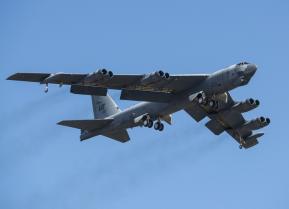Convair B-36 Peacemaker: Meet the Biggest Bomber Ever Built
Though the B-36 Peacemaker is noted for being among the first early Cold War aircraft, its development began in 1941 to meet the U.S. Army Air Corps' (later Army Air Forces) requirement for a strategic bomber with intercontinental range as there was the question of stability of overseas bases.
Keeping the Peace With the B-36 - The Boeing B-52 Stratofortress is the largest bomber in service with the United States Air Force today. However, it isn't actually the largest bomber ever built!
That distinction would go to the Convair B-36 "Peacemaker," a strategic bomber that was operated from 1949 to 1959. It was also the largest mass-produced piston engine aircraft ever built – and had the longest wingspan of any combat aircraft at 230 feet (70 meters).
Though dubbed the "Peacemaker," it was the first bomber to be designed to carry nuclear weapons without aircraft modifications. With a maximum payload of 87,200 pounds (39,600 kg), the B-36 had a range of 10,000 miles (16,000 km) and was capable of intercontinental flight without refueling.
A World War II Bomber For the Cold War
Though the B-36 Peacemaker is noted for being among the first early Cold War aircraft, its development began in 1941 to meet the U.S. Army Air Corps' (later Army Air Forces) requirement for a strategic bomber with intercontinental range as there was the question of stability of overseas bases.
The U.S. military saw a need for a bomber that could attack Europe from bases in North America, and the requirements set forth by the then Army Air Corps were very ambitious for the day. In November 1941, Consolidated Vultee (later Convair) won the contract with its Model 36 design – beating out Boeing's Model 385. With its wingspan of 230 feet, and powered by six 28-cylinder Pratt & Whitney R-4360 "XWasp" air-cooled radial engines for takeoff, as well as a fuselage length of 163 feet equipped with four bomb bays with a maximum capacity of 87,200 pounds, the aircraft was truly a leap forward.
It was unique in that it also was equipped with four General Electric J47 turbojet engines in pylon-mounted pods outboard of piston engines. This allowed the aircraft to cruise at 230 mph, and for additional bursts of speed, its four General Electric J47s increased the maximum speed to 435 mph.
Larger than any aircraft of the era, the B-36 dwarfed even the B-29 Superfortress. Yet, its size, weight, and complexity presented numerous problems that the engineers and technicians had to address. It arrived too late for the Second World War.
When it was first flown in August 1946, the XB-36 was the largest and heaviest aircraft to date. It took two more years for the bomber to finalize its design and address several issues. It entered service with the Strategic Air Command (SAC) in 1948, but due to lingering problems, the B-36 units were not fully operational until 1951.
It wasn't exactly a "cheap" aircraft. Each cost around $3.6 million – a considerable sum for the day.
Short Service History
A total of 380 were produced with the final aircraft rolling off the assembly line in August 1954, and a year later the B-52 entered service. Some B-36s served as photographic reconnaissance aircraft, while others were adapted to launch and retrieve specially modified RF-84F/K reconnaissance planes – but the Peacemaker was officially retired in 1959.

Although never used in a conflict, the B-36 is remembered for being a major deterrent to enemy aggression – a point made by the Federation of American Scientists, which noted, "The fact that the B-36 was never used in combat was indicative of its value in "keeping the peace.'"
The aircraft earned fame when it was "flown" by screen legend Jimmy Stewart – a real-life Air Force Reserve brigadier general – in the film "Strategic Air Command."
Of the 385 B-36 aircraft constructed (including prototypes), only four intact airframes survived the scrapper's torch. One is at the Castle Air Museum in Atwater, California, while another is at the Strategic Air Command and Aerospace Museum in Ashland, Nebraska. The final B-36 built is now in the collection of the Pima Air and Space Museum, adjacent to Davis–Monthan Air Force Base in Tucson, Arizona.
The last flight of the B-36 saw B-36J (52-2220) flown from Davis -Monthan AFB to the National Museum of the United States Air Force at Wright-Patterson AFB, Ohio, on April 30, 1959. That aircraft is now on display in the Cold War gallery, alongside the only surviving example of the massive 9 ft (2.7 m) lower main gear strut, single wheel, and tire that was used on the original XB-36.
A Civilian Model?
Even as Convair was developing the B-36, it began work on the Convair Model 37, a planned civil passenger jet based on the bomber. It shared the wings and some other structures. It attracted interest from Pan American Airways for its transatlantic service, which initially ordered 15 of the aircraft, but fuel and oil consumption for the six engines was deemed not economically viable.
Lacking the orders to initiate production, the project was abandoned in 1949.
The sole prototype, designated the XC-99, is now in the collection of the National Museum of the Museum of the United States Air Force after being maintained in storage at Davis-Monthan AFB for several years. It is currently pending financial resources to see it restored.
Author Experience and Expertise
Peter Suciu is a Michigan-based writer. He has contributed to more than four dozen magazines, newspapers, and websites with over 3,200 published pieces over a twenty-year career in journalism. He regularly writes about military hardware, firearms history, cybersecurity, politics, and international affairs. Peter is also a Contributing Writer for Forbes and Clearance Jobs. You can follow him on Twitter: @PeterSuciu.
Image Credit: All Images are Creative Commons.


